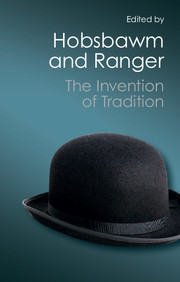Book contents
- Frontmatter
- Contents
- Contributors
- 1 Introduction: Inventing Traditions
- 2 The Invention of Tradition: The Highland Tradition of Scotland
- 3 From a Death to a View: The Hunt for the Welsh Past in the Romantic Period
- 4 The Context, Performance and Meaning of Ritual: The British Monarchy and the ‘Invention of Tradition’, c. 1820–1977
- 5 Representing Authority in Victorian India
- 6 The Invention of Tradition in Colonial Africa
- 7 Mass-Producing Traditions: Europe, 1870–1914
- Index
2 - The Invention of Tradition: The Highland Tradition of Scotland
Published online by Cambridge University Press: 05 July 2014
- Frontmatter
- Contents
- Contributors
- 1 Introduction: Inventing Traditions
- 2 The Invention of Tradition: The Highland Tradition of Scotland
- 3 From a Death to a View: The Hunt for the Welsh Past in the Romantic Period
- 4 The Context, Performance and Meaning of Ritual: The British Monarchy and the ‘Invention of Tradition’, c. 1820–1977
- 5 Representing Authority in Victorian India
- 6 The Invention of Tradition in Colonial Africa
- 7 Mass-Producing Traditions: Europe, 1870–1914
- Index
Summary
Today, whenever Scotchmen gather together to celebrate their national identity, they assert it openly by certain distinctive national apparatus. They wear the kilt, woven in a tartan whose colour and pattern indicates their ‘clan’; and if they indulge in music, their instrument is the bagpipe. This apparatus, to which they ascribe great antiquity, is in fact largely modern. It was developed after, sometimes long after, the Union with England against which it is, in a sense, a protest. Before the Union, it did indeed exist in vestigial form; but that form was regarded by the large majority of Scotchmen as a sign of barbarism: the badge of roguish, idle, predatory, blackmailing Highlanders who were more of a nuisance than a threat to civilized, historic Scotland. And even in the Highlands, even in that vestigial form, it was relatively new: it was not the original, or the distinguishing badge of Highland society.
Indeed, the whole concept of a distinct Highland culture and tradition is a retrospective invention. Before the later years of the seventeenth century, the Highlanders of Scotland did not form a distinct people. They were simply the overflow of Ireland. On that broken and inhospitable coast, in that archipelago of islands large and small, the sea unites rather than divides and from the late fifth century, when the Scots of Ulster landed in Argyll, until the mid-eighteenth century, when it was ‘opened up’ after the Jacobite revolts, the West of Scotland, cut off by mountains from the East, was always linked rather to Ireland than to the Saxon Lowlands. Racially and culturally, it was a colony of Ireland.
- Type
- Chapter
- Information
- The Invention of Tradition , pp. 15 - 42Publisher: Cambridge University PressPrint publication year: 2012
- 23
- Cited by

